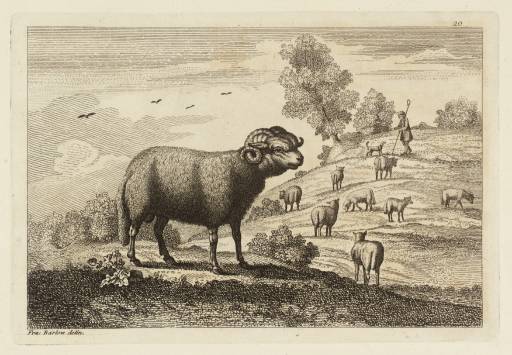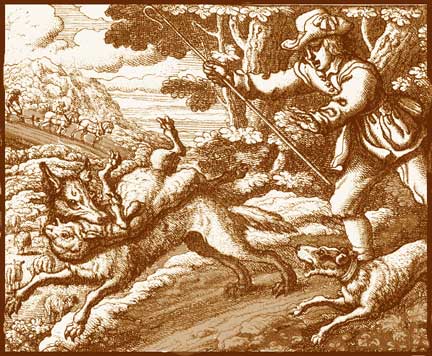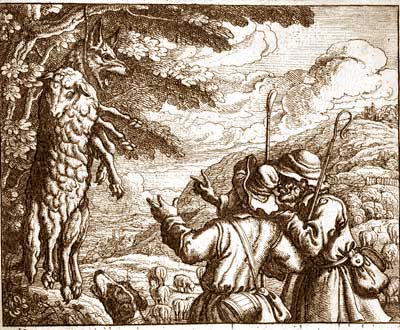

![]()
FRANCIS BARLOW
1626-1704

Above, a pastoral scene by Francis Barlow.
If you look very closely, you can see a shepherd (leaning on his crook)
and a sheepdog, in the distance on the hill.
Born in Lincolnsire, Francis Barlow seems to have moved to London when he was very young to be apprenticed to a portrait painter named Shepherd. He stayed with Shepherd only a few years, as "his taste lay in birds, fish, and animals", says (George H. Shepherd, The British School of Painting, 1891).
Barlow went on from these humble beginnings to become an accomplished painter, etcher, and book illustrator, who has been considered the leading bird and animal artist of 17th century England, and "the father of British sporting painting" (hunting scenes).
Barlow's first major work was the illustration of Edward Benlowes' Theophila (1652, a poetical work describing "the souls longing for and eventual union with God" (St. John's College, Cambridge)). Aubrey Noakes (Sportsman in a Landscape, 1971, Ayer Publishing, Chapter IV: "Through Stuart England with Francis Barlow") said "Barlow was one of the earliest English painters to specialise in large, decorative paintings in which birds, dead fish, farm animals, horses and dogs are placed against impressive landscape backgrounds." Barlow also had published books of animal engravings from his drawings, and he painted ceilings of birds for the houses of country gentlemen.

Above, an illustration for the Aesop's Fable "The Boy That Cried Wolf".
However, Francis Barlow is best known for his 1666 edition of Aesop's Fables with 30 full page engravings and 110 in-text engravings. At least two of his illustrations for Aesop show shepherds' dogs. They are both rather grisly. "The Boy That Cried Wolf" is a well-known tale. The shepherd boy cried "Wolf!" falsely so many times that when the wolf actually attacked his flock no one responded. In this illustration (above), the boy is at least assisted by his loyal, smooth-coated sheepdog. In the illustration below, for the tale "The Wolf in Sheep's Clothing", the wolf has been hung for his transgressions. A black and white sheepdog can be seen in the lower left.

Above, an illustration for the Aesop's Fable "The Wolf in Sheep's Clothing
The Fables were also brought out in a 1687 folio edition with many added illustrations. Barlow has been criticized as an artist but his work is more in the style of much later illustrative works and he makes skillful use of composition, filling the screen, as it were, with only what is necessary to tell the story. One cannot say that Barlow advanced the history of the shepherd's dog beyond Caius, but it is apparant from Barlow's illustrations that the shepherd's dog as we know it was alive and well in the 200 years between Caius and Bewick.
Sadly, Francis Barlow was said to have died in poverty in York.
Copyright 2008 by Carole L. Presberg
THE OTHER WEB PAGES WE MAINTAIN
These web pages are copyright ©2013
and maintained by webmeistress Carole Presberg
with technical help from webwizard David Presberg
ALL RIGHTS RESERVED
If you are interested in using ANY material on this website, you MUST first ask for permission.
You may email us at carole@woolgather.org.